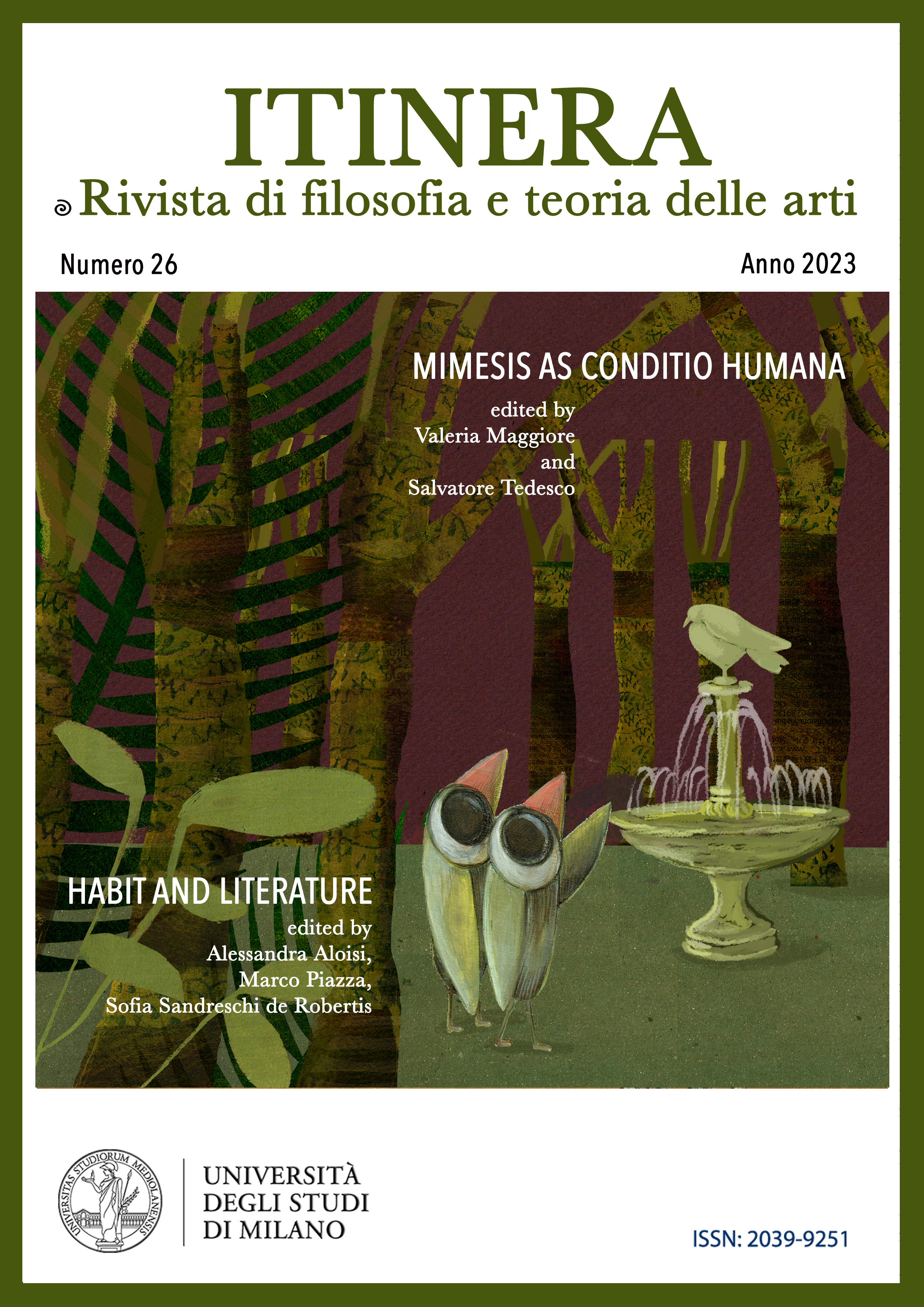Development and Natural Selection, the Historical Foundations of Mimesis in Animal and Plant Form
DOI:
https://doi.org/10.54103/2039-9251/22231Parole chiave:
adaptation, aevelopmental aonstraints, evo-devo, mimicry.Abstract
In biology, mimesis includes imitation between individuals of the same species – the study object of behavioral sciences and neurophysiology – and mimicry between different species through traits or behaviours generally common to all individuals – to be analyzed from an evolutionary and morphogenetic perspective. Mimicry is widespread among representatives of many animal lineages, but has been also recorded among plants. Mimicry is very often adaptive, e.g. because of protection produced by the similarity of a harmless animal to a poisonous or otherwise dangerous one (Batesian mimicry, e.g., false vs. true coral snakes, or hoverflies vs. wasps), or by sharing of closely similar livery by animals protected by different weapons (Müllerian mimicry). Less conventional kinds of mimicry include the aggressive behaviour of some fireflies imitating the flashing of a different species on which they prey; the intraspecific Müllerian mimicry between larva and adult of some ladybirds; and the presence of identical compounds in the sexual pheromone produced by a female wasp and in the fragrance of the orchid species pollinated by the male. Morphological and biochemical similarity cannot be explained by selective advantage only. Even in cases of adaptive mimicry, shared developmental constraint may facilitate the evolution of similarity between model and mime.
Riferimenti bibliografici
Akino, T., Chemical strategies to deal with ants: a review of mimicry, camouflage, propaganda, and phytomimesis by ants (Hymenoptera: Formicidae) and other arthropods, in “Myrmecological News”, XI, 2008, pp.173-181.
Aslam, M., Veselý, P., Nedvěd, O., Response of passerine birds and chicks to larvae and pupae of ladybirds, in “Ecological Entomology”, XLIV, 2019, pp. 792-799.
Benson, W.W., Brown, K.S. Jr., Gilbert, L.E., Coevolution of plants and herbivores: passion flower butterflies, in “Evolution”, XXIX, 1975, pp. 659-680.
Brown, K.S., The biology of Heliconius and related genera, in “Annual Reviews of Entomology”, XXVI, 1881, pp. 427-456.
Cushing, P.E., Spider-ant associations: an updated review of myrmecomorphy, myrmecophily, and myrmecophagy in spiders, in “Psyche”, 2012, 151989.
Darwin, C., On the various contrivances by which British and foreign orchids are fertilised by insects: and on the good effect of intercrossing, John Murray, London 1862.
Dell’Aglio, D.D., Losada, M.E., Jiggins, C. D., Butterfly learning and the diversification of plant leaf shape, in “Frontiers in Ecology and Evolution”, IV, 2016, 81.
Di Pellegrino G., Fadiga L., Fogassi L., Gallese V., Rizzolatti G., Understanding motor events: a neurophysiological study, in “Experimental Brain Research”, XCI, 1992, pp. 176-180.
Gallese, V., Fadiga, L., Fogassi, L., Rizzolatti, G., Action recognition in the premotor cortex, in “Brain”, CXIX, 1996, pp. 593-609.
Gallese, V., Gernsbacher, M.A., Heyes, C., Hickok, G., Iacoboni, M., Mirror neuron forum, in “Perspectives on Psychological Science”, VI, 2011, pp. 369-407.
Gianoli, E., Carrasco-Urra, F., Leaf mimicry in a climbing plant protects against herbivory, in “Current Biology”, XXIV, 2014, pp. 984-987.
Gilbert, L. E., The coevolution of a butterfly and a vine, in “Scientific American”, CCXLVII, 1982, pp. 110-121.
Gilbert, L.E., Ecological consequences of a co-evolved mutualism between butterflies and plants, in L. E. Gilbert and P. R. Raven (eds.), Coevolution of animals and plants, University of Texas Press, Austin. 1975, pp. 210-240.
Grimaldi, D., Engel, M.S., Evolution of the insects, Cambridge University Press, Cambridge 2005.
Heyes, C., Catmur, C., What happened to mirror neurons?, in “Perspectives on Psychological Science”, XVII, 2022, pp. 153-168.
Lloyd, J.E., Aggressive mimicry in Photuris fireflies: signal repertoires by femmes fatales, in “Science”, CLXXXVII, 1975, pp. 452-453.
Lloyd, J.E., Aggressive mimicry in Photuris: firefly femmes fatales, in “Science”, CXLIX, 1965, pp. 653-654.
Marchini, M., Sommaggio, D., Minelli A., Playing with black and yellow: the evolvability of a Batesian mimicry, in “Evolutionary Biology”, XLIV, 2017, pp. 100-112.
Minelli, A., An evo-devo perspective on analogy in biology, in “Philosophies”, IV, 2019, 5.
Pasteur, G., A classificatory review of mimicry systems, in “Annual Review of Ecology and Systematics”, XIII, 1982, pp. 169-199.
Paulus, H.F., Deceived males – Pollination biology of the Mediterranean orchid genus Ophrys (Orchidaceae), in “Journal Europäischer Orchideen”, XXXVIII, 2006, pp. 303-353.
Porter-Utley, K., A revision of Passiflora L. subgenus Decaloba (DC.) Rchb. supersection Cieca (Medik.) J.M. MacDougal & Feuillet (Passifloraceae), in “PhytoKeys”, XLIII, 2014, pp. 1-224.
Rizzolatti, G., Fadiga, L., Gallese, V., Fogassi, L., Premotor cortex and the recognition of motor actions, in “Social Cognitive and Affective Neuroscience”, III, 1996, pp. 131-141.
Rizzolatti, G., Sinigaglia, C., So quel che fai, Il cervello che agisce e i neuroni specchio, Raffaello Cortina Editore, Milano 2006.
Schiestl, F.P., Peakall, R., Mant, J. G., Ibarra, F., Schulz, C., Franke, S. & Francke, W., The chemistry of sexual deception in an orchid-wasp pollination system, in “Science”, CCCII, 2003, pp. 437-438.
White, J., Yamashita, F., Boquila trifoliolata mimics leaves of an artificial plastic host plant, in “Plant Signaling & Behavior”, XVII, 2022, 17, 1977530.
Dowloads
Pubblicato
Fascicolo
Sezione
Licenza
Copyright (c) 2024 Minelli

Questo lavoro è fornito con la licenza Creative Commons Attribuzione - Condividi allo stesso modo 4.0.
Gli autori che pubblicano su questa rivista accettano le seguenti condizioni:
1. Gli autori mantengono i diritti sulla loro opera e cedono alla rivista il diritto di prima pubblicazione dell'opera, contemporaneamente licenziata sotto una Licenza Creative Commons - Attribuzione - Condividi allo stesso modo 4.0 internazionale che permette ad altri di condividere l'opera indicando la paternità intellettuale e la prima pubblicazione su questa rivista.
2. Gli autori possono aderire ad altri accordi di licenza non esclusiva per la distribuzione della versione dell'opera pubblicata (es. depositarla in un archivio istituzionale o pubblicarla in una monografia), a patto di indicare che la prima pubblicazione è avvenuta su questa rivista.
3. Gli autori possono diffondere la loro opera online (es. in repository istituzionali o nel loro sito web) prima e durante il processo di submission, poiché può portare a scambi produttivi e aumentare le citazioni dell'opera pubblicata (Vedi The Effect of Open Access).





